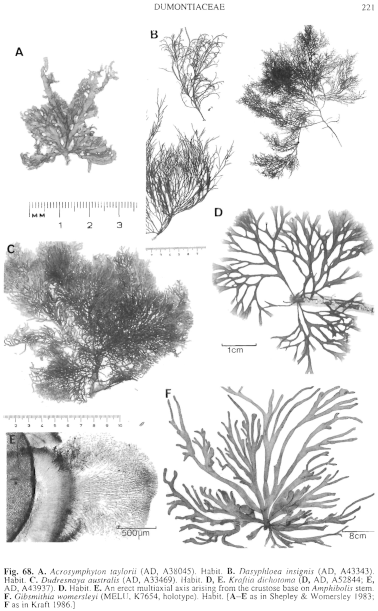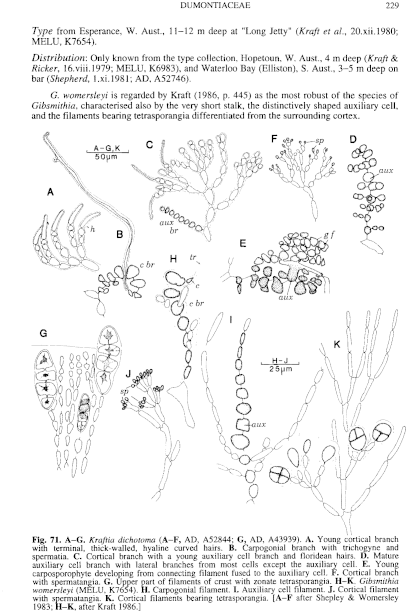|
|
|
|
|
|||||||||||
|
Electronic Flora of South Australia Species Fact Sheet
Phylum Rhodophyta – Class Florideophyceae – Order Gigartinales – Family Dumontiaceae
Thallus (Fig. 68F) red-brown, fading to grey-brown, erect, 3–48 cm high, with a short, cartilaginous stalk 4–11 mm broad bearing terete to compressed, linear to irregularly branched mucilaginous branches 2–30 mm in diameter, branched at intervals of 2–20 cm, ends rounded. Holdfast crustose to conical, cartilaginous, 4–11 mm across; epilithic or on jetty piles. Structure multiaxial, with a filamentous medulla of long cells 7–10 µm in diameter, producing numerous rhizoids 4–5 µm in diameter; the latter may fuse laterally with other filaments, or medullary filaments may fuse directly; cortical filaments pseudodichotomous, 9–15 cells long, cells 4–6 µm in diameter and L/D 4–7 below, apical cells 3–4 µm in diameter and L/D 3–6, with occasional hairs; rhodoplasts parietal, becoming dissected in inner cells.
Reproduction: Sexual thalli dioecious. Carpogonial branches (Fig. 71H) 6–8 (–11) cells long, with the mid and upper cells enlarged, the hypogynous cell largest and excentric; short, sterile, lateral filaments (Fig. 71H) occasionally present. Auxiliary cell branches (Fig. 71I) 9–19 cells long, terminating as vegetative cells, and the basal 3–4 cells bearing 1–5 usually unbranched laterals; auxiliary cell smaller than adjacent cells, trapezoidal in shape. Carposporophytes at first with discrete gonimolobes, when mature 120–250 µm in diameter, with ovoid to angular carposporangia 8–15 µm in diameter and 10–35 µm long. Spermatangia (Fig. 71J) clustered, cut off from initials at ends of cortical filaments.
Tetrasporophytes with clustered tetrasporangia (Fig. 71K) on ends of cortical filaments, cruciately (usually decussately) divided, ovoid, 15–25 µm in diameter.
Type from Esperance, W. Aust., 11–12 m deep at "Long Jetty" (Kraft et al., 20.xii.1980; MELU, K7654).
Distribution: Only known from the type collection, Hopetoun, W. Aust., 4 m deep (Kraft & Ricker, 16.viii.1979; MELU, K6983), and Waterloo Bay (Elliston), S. Aust., 3–5 m deep on bar (Shepherd, 1.xi.1981; AD, A52746).
Taxonomic notes: G. womersleyi is regarded by Kraft (1986, p. 445) as the most robust of the species of Gibsmithia, characterised also by the very short stalk, the distinctively shaped auxiliary cell, and the filaments bearing tetrasporangia differentiated from the surrounding cortex.
References:
KRAFT, G.T. (1986). The genus Gibsmithia (Dumontiaceae, Rhodophyta) in Australia. Phycologia 25, 423–447.
The Marine Benthic Flora of Southern Australia Part IIIA complete list of references.
Publication:
Womersley, H.B.S. (14 January, 1994)
The Marine Benthic Flora of Southern Australia
Rhodophyta. Part IIIA, Bangiophyceae and Florideophyceae (to Gigartinales)
Reproduced with permission from The Marine Benthic Flora of Southern Australia Part IIIA 1994, by H.B.S. Womersley. Australian Biological Resources Study, Canberra. Copyright Commonwealth of Australia.
Illustrations in Womersley Part IIIA, 1994: FIGS 68F, 71 H–K.

Figure 68 enlarge
Fig. 68. A. Acrosymphyton taylorii (AD, A38045). Habit. B. Dasyphloea insignis (AD, A43343). Habit. C. Dudresnaya australis (AD, A33469). Habit. D, E. Kraftia dichotoma (D, AD, A52844; E, AD, A43937). D. Habit. E. An erect multiaxial axis arising from the crustose base on Amphibolis stem. F. Gibsmithia womersleyi (MELU, K7654, holotype). Habit. [A–E as in Shepley & Womersley 1983; F as in Kraft 1986.]

Figure 71 enlarge
Fig. 71. A–G. Kraftia dichotoma (A–F, AD, A52844; G, AD, A43939). A. Young cortical branch with terminal, thick-walled, hyaline curved hairs. B. Carpogonial branch with trichogyne and spermatia. C. Cortical branch with a young auxiliary cell branch and floridean hairs. D. Mature auxiliary cell branch with lateral branches from most cells except the auxiliary cell. E. Young carposporophyte developing from connecting filament fused to the auxiliary cell. F. Cortical branch with spermatangia. G. Upper part of filaments of crust with zonate tetrasporangia. H–K. Gibsmithia womersleyi (MELU, K7654). H. Carpogonial filament. I. Auxiliary cell filament. J. Cortical filament with spermatangia. K. Cortical filaments bearing tetrasporangia. [A–F after Shepley & Womersley 1983; H–K, after Kraft 1986.]

|
Email Contact: State Herbarium of South Australia |

|